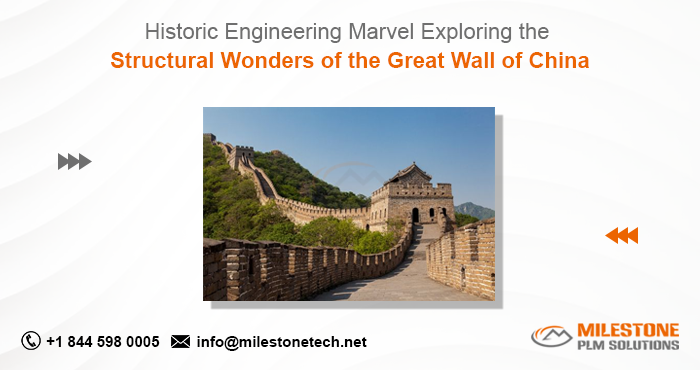Historic Engineering Marvel: Exploring the Structural Wonders of the Great Wall of China
The Great Wall of China, an iconic symbol of Chinese civilisation, stands as one of the most remarkable architectural feats in human history. Stretching for thousands of miles across rugged terrain, this ancient structure is a testament to the ingenuity, perseverance, and engineering prowess of ancient Chinese builders. In this blog post, we will delve into the structural wonders of the Great Wall of China, exploring its historical significance, construction techniques, and enduring legacy.
Contents |
[edit] A Brief History of the Great Wall
The Great Wall of China is not a single, continuous wall but rather a series of fortifications built over centuries to protect the Chinese Empire from invasions. Construction began during the Qin Dynasty (221-206 BCE), when Emperor Qin Shi Huang ordered the unification of existing walls along the northern frontier. Over the following centuries, various dynasties expanded and repaired the wall, resulting in a complex and multifaceted structure.
[edit] The Structural Marvels of the Great Wall
The Great Wall's construction is a testament to ancient Chinese engineering ingenuity. The wall's sections vary in width and height depending on the terrain and defensive needs. In some areas, the wall is wide enough to accommodate multiple layers of troops and equipment. The wall's foundation is typically made of stone or packed earth, providing a solid base for the superstructure. The above-ground portions of the wall are often constructed of rammed earth, a mixture of soil, water, and other materials that is compacted into layers to form a durable structure.
One of the most impressive features of the Great Wall is its system of watchtowers. These strategically placed towers served as observation posts, allowing soldiers to monitor the surrounding countryside and detect potential threats. The watchtowers are often multi-story structures with crenellated walls and lookout platforms. Some towers also included living quarters for soldiers and storage facilities.
[edit] The Challenges of Construction
Building the Great Wall was a monumental undertaking, fraught with challenges. The construction process required a massive workforce, and labourers often faced harsh conditions, including extreme weather, difficult terrain, and the threat of enemy attacks. The transportation of materials, such as stones and timber, over long distances was another significant challenge. Despite these obstacles, the ancient Chinese builders succeeded in creating a structure that has endured for centuries.
[edit] The Great Wall's Enduring Legacy
Today, the Great Wall of China is a UNESCO World Heritage Site and a popular tourist destination. It serves as a symbol of Chinese history, culture, and resilience. The wall's construction techniques and architectural features continue to inspire engineers and architects around the world.
In conclusion, the Great Wall of China is a truly remarkable engineering marvel. Its construction represents a testament to the ingenuity, perseverance, and skill of ancient Chinese builders. The wall's enduring legacy serves as a reminder of the power of human ingenuity and the importance of preserving our cultural heritage.
Featured articles and news
One of the most impressive Victorian architects. Book review.
RTPI leader to become new CIOB Chief Executive Officer
Dr Victoria Hills MRTPI, FICE to take over after Caroline Gumble’s departure.
Social and affordable housing, a long term plan for delivery
The “Delivering a Decade of Renewal for Social and Affordable Housing” strategy sets out future path.
A change to adoptive architecture
Effects of global weather warming on architectural detailing, material choice and human interaction.
The proposed publicly owned and backed subsidiary of Homes England, to facilitate new homes.
How big is the problem and what can we do to mitigate the effects?
Overheating guidance and tools for building designers
A number of cool guides to help with the heat.
The UK's Modern Industrial Strategy: A 10 year plan
Previous consultation criticism, current key elements and general support with some persisting reservations.
Building Safety Regulator reforms
New roles, new staff and a new fast track service pave the way for a single construction regulator.
Architectural Technologist CPDs and Communications
CIAT CPD… and how you can do it!
Cooling centres and cool spaces
Managing extreme heat in cities by directing the public to places for heat stress relief and water sources.
Winter gardens: A brief history and warm variations
Extending the season with glass in different forms and terms.
Restoring Great Yarmouth's Winter Gardens
Transforming one of the least sustainable constructions imaginable.
Construction Skills Mission Board launch sector drive
Newly formed government and industry collaboration set strategy for recruiting an additional 100,000 construction workers a year.
New Architects Code comes into effect in September 2025
ARB Architects Code of Conduct and Practice available with ongoing consultation regarding guidance.
Welsh Skills Body (Medr) launches ambitious plan
The new skills body brings together funding and regulation of tertiary education and research for the devolved nation.
Paul Gandy FCIOB announced as next CIOB President
Former Tilbury Douglas CEO takes helm.























